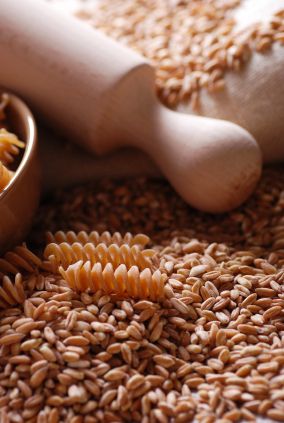Whole Wheat Pasta
Is it really whole grain?

Is it really whole wheat pasta?
I was discussing making pasta salad with an acquaintance the other day when the subject of whole-wheat pasta came up. Knowing my concern about too many refined white flour products in the average diet, she assured me that she only uses whole-wheat pasta. Curious, I asked her what brand she used and was she sure it was whole grain?
She promptly went to the cupboard and pulled out the box and read me the ingredients.The main ingredient was “semolina” with some oat fiber, and other ingredients added, probably for taste and texture and to increase the fiber content, since we are all paying attention to that these days.
Whole wheat pasta means the entire grain is there.
Now, I want to make something perfectly clear. There is only one ingredient needed to make whole-wheat pasta. Whole wheat. Period. How difficult is that?
In case you were wondering, semolina is a processed form of wheat that is produced when wheat is fed into a mill and the rollers cause the bran and germ to flake off, while the starch (or endosperm) is cracked into coarse pieces. Through sifting, these particles are separated from the bran and what is left is called semolina.
Since the bran and germ are removed, semolina is essentially coarse white flour and not whole-wheat at all. They did add some fiber back in the form of oat fiber, since people are looking for fiber in foods, but you lose the germ, the most nutritious part of the wheat kernel.

MY TWO CENTS
Discriminating digestive system
I discovered the difference between whole-wheat pasta and what passes for it in many grocery stores, when my husband picked up some “whole wheat” pasta for a new lasagna recipe I was trying. The brand he brought home was not “Hodgson Mill" which is what I generally buy, but it said whole grain on the box so, without further ado, I assembled, baked and enjoyed the new version of one of our favorite dishes.
A few hours later, I started to experience digestive upset, which is not a common occurrence for me. I didn’t think much about it until the same thing happened the next day when I ate some lasagna for lunch. I’m not sure what made me check the pasta box, but I discovered that it wasn’t whole wheat or whole grain, but a white flour concoction with some fiber and coloring added to make it look like whole wheat. It was very likely that one of the added ingredients was making my system cranky!
Just to prove the point to myself, that same week, I bought some Hodgson Mill whole wheat pasta (one ingredient only, and you know what it is!) and made a new batch of the same lasagna. This time I had no digestive difficulties at all.
Just to be sure it wasn't a digestive aberration from some other cause, I went back to the first batch, the same problem occurred. That settled it for me.
Why make it more complicated?
If you have ever made your own pasta, you know that it is basically made of flour and water, with possibly some egg and salt. My guess is that these food companies have strayed from that recipe because they are trying to make their product act more like white flour pasta, in taste and texture, but with the fiber content of its whole grain counterpart. This is not necessarily a bad thing, unless people are fooled into thinking they are buying the more nutritious whole wheat pasta.
It's all about being an informed consumer.
My concern is that people like me will try these brands and when it disagrees with them, they will go back to the white pasta that is more acceptable to their digestive system. On the other hand, if they know the difference between whole-wheat pasta and white pasta with fiber added, they can make an informed choice.
Interesting Fact: Did you know that if you eat your white pasta "al dente," that is, while it is still firm, it has more fiber than if it is fully cooked, since some of the starch will pass through your system undigested?
In case all of this talk has made you hungry for pasta, here are some ideas that include this popular carbohydrate food.
You can make variations of macaroni salad using real whole wheat pasta in the form of elbows or bow ties, plus other ingredients such as chopped zucchini, hard-boiled eggs, green peas, chopped carrots, chopped bell peppers, chopped olives, chopped celery, chopped pickles, shredded cheese, Parmesan cheese, mayo, Greek yogurt, Celtic Sea Salt and turmeric.
For potluck picnics, try making a pasta salad with whole wheat rotini pasta , cherry tomatoes, broccoli and cauliflower florets, carrots, whole, pitted olives, feta cheese, Parmesan cheese, and vinegar and oil dressing (If you don't want to make your own, Newman's Own has a good product.)
Macaroni and cheese becomes more than a comfort food when you use whole wheat pasta and real cheeses. Just make a light white sauce, melt the cheese in it and pour it over cooked macaroni. It can be served as is, or placed in a casserole dish with whole wheat bread or cracker crumbs on top for a more elegant presentation.
Check the label.
My husband and I learned the hard way to always check labels to insure that we are buying the products we need and want. It is easy to assume that a product is what we think it is, but it only takes a moment to be sure.
Whole wheat pasta made from whole wheat! It's not exactly rocket science!
Eat and be healthy with my warmest regards,


